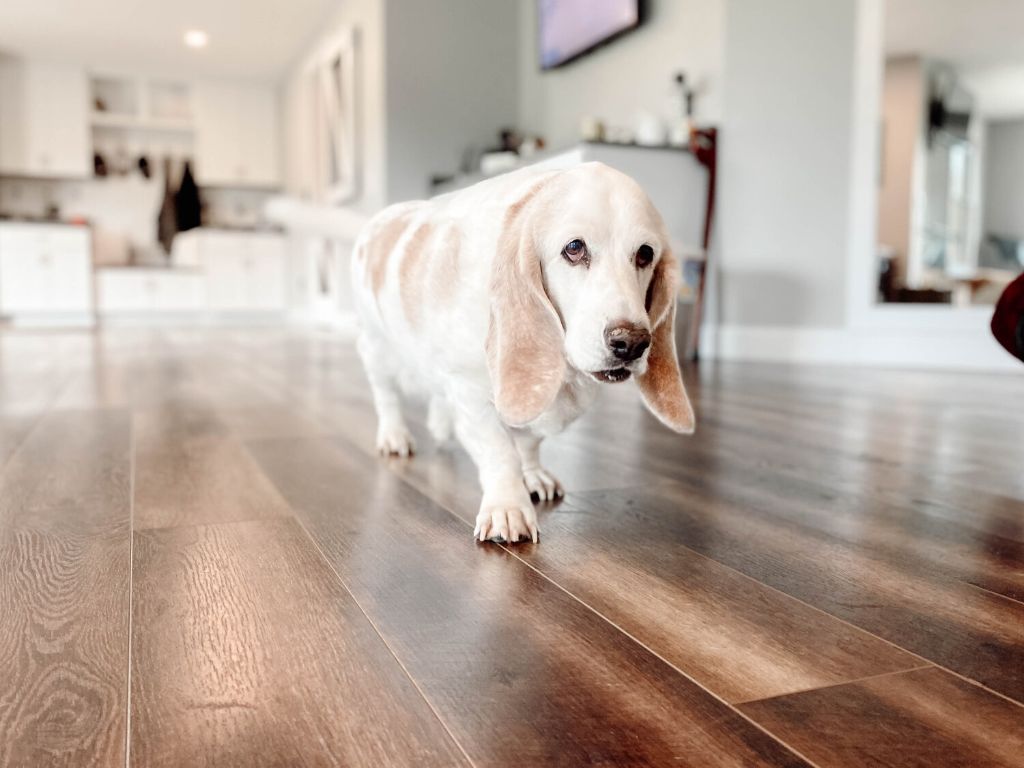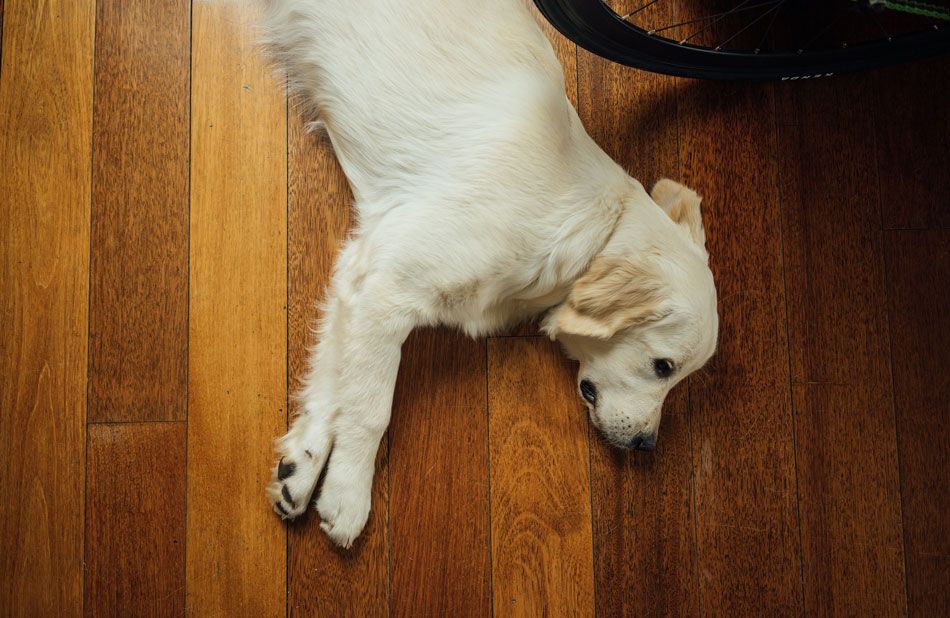Luxury Vinyl Tile or LVT has become increasingly popular in homes with dogs or other pets. LVT is a durable, scratch-resistant flooring that can withstand the wear and tear of paws, nails, accidents and daily activity. Here’s an overview of how LVT construction gives it strength and resilience against damage while still providing style and versatility.
LVT Construction
LVT flooring is comprised of multiple layers that provide the floor’s durability, design, and structure. The primary layers include:
- Wear layer – This clear top layer provides scratch and stain resistance. It is usually 20 mil thick for residential use and 30-40 mil thick for commercial applications (Get the Dirt on Luxury Vinyl Tile (LVT)).
- Print layer – The print layer underneath the wear layer is what gives LVT its realistic wood, stone, or tile look. Advanced printing technology allows the pattern to go all the way through the layer for long-lasting visuals.
- Core layer – This bottom layer forms the core structure of the LVT flooring. It is usually made of limestone composite or polyvinyl chloride (PVC) which provides rigidness to support the floor (Refined Forest Platinum | Luxury Vinyl Tile).
Together, these layers create a durable, attractive, and structurally-sound vinyl floor.
LVT Durability
One of the biggest benefits of LVT is its durability. LVT is an extremely resilient flooring option that stands up well to heavy foot traffic, moving furniture, pet claws, and more. Luxury vinyl tile is 100% waterproof, making it ideal for kitchens, baths, laundry rooms, and basements where moisture may be an issue (source). The vinyl wear layer provides scratch and dent resistance while the rigid core adds strength and prevents indentation from heavy objects.

LVT does not absorb moisture and will not warp, buckle or expand when exposed to water like wood or laminate floors can. The seams are sealed tight during installation to prevent water seepage underneath (source). Daily mopping and occasional flooding won’t damage luxury vinyl floors. They can withstand puddles, pet accidents, and spills without issue. LVT stands up to heavy wheeled traffic from appliances, furniture, and more without leaving dents.
Scratch Resistance
One of the biggest concerns with dogs and flooring is scratching from nails. LVT is designed to resist scratches thanks to its durable wear layer.
LVT features a transparent PVC wear layer on top that protects the printed design layer underneath. This wear layer is typically 20 mil (0.5mm) thick in residential applications. Some premium LVT floors feature an enhanced urethane coating for even greater scratch protection.
This thick wear layer helps prevent scratches from penetrating the floor’s surface. Light scratching may affect the finish but won’t damage the flooring beneath. This allows LVT floors to better maintain their appearance compared to alternatives like hardwood or laminate.
Scratch resistance is an important advantage of LVT with dogs. While no floor is completely scratch-proof, LVT is engineered to prevent deep gouges that can permanently mar the floor’s look. The rigid vinyl core adds to the durability against scratches and dents.
LVT With Pets
LVT is a good option for homes with pets because it is quite durable. The dense and rigid core of LVT makes it resistant to scratching, denting, and warping, even against pets’ nails and claws. According to RCR Designer Flooring, LVT “is one of the most scratch-resistant floors available.” The durable vinyl wear layer provides protection against scrapes and scratches from pet nails.

Compared to options like hardwood, LVT will not show scratches as easily. The surface pattern and design helps hide minor scratching from pets. LVT is waterproof as well, so any accidents are easy to clean up without permenant damage.
Dogs on LVT
One of the biggest concerns pet owners have about flooring is scratching from dog nails. LVT is an excellent choice for homes with dogs because of its durability and scratch resistance. The layered construction of LVT makes it able to withstand scratching and gouging much better than materials like hardwood or laminate.
LVT is comprised of four layers – a clear vinyl wear layer, a printed design layer, a rigid vinyl core, and a vinyl backing. The top clear wear layer is key for scratch resistance, as it provides a protective barrier over the floor’s design. This layer is typically 20 mils thick in residential LVT, but can be up to 30 mils thick for commercial applications. The thicker the wear layer, the more durable and scratch resistant the floor will be.
According to Floor & Decor, LVT designed for pets will have an embossed wear layer for added protection. The embossing helps conceal micro scratches from dog nails. Overall, LVT stands up extremely well to scratches with minimal visible damage over time.
Cleaning LVT
One of the benefits of LVT floors is that they are easy to clean, even pet messes. LVT is resistant to stains and spills thanks to the durable vinyl wear layer on top. According to Armstrong Flooring, a damp mop is often sufficient to clean LVT floors[1]. For tougher messes, a vinyl floor cleaner can be used, but avoid harsh chemicals that may damage the floor[2].
Pet messes like urine can be easily cleaned with a damp mop and pet-safe vinyl floor cleaner. It’s important to clean messes quickly before the urine can soak in or stain. With responsible pet owners who clean up properly, LVT can stand up well to dogs with minimal effect on the floor’s appearance.

Sealing LVT
Sealing vinyl flooring like LVT is an optional step that can add extra protection and longevity. LVT is durable on its own, but applying a quality sealer creates an extra moisture barrier and helps prevent stains, scratches, and dents. Sealers smooth over the textured vinyl surface to make cleaning easier as well. Look for water-based acrylic sealers specifically made for vinyl floors. Make sure to prep the floor thoroughly and allow the sealer to cure fully before walking on the floor. Reapply the sealer every 1-2 years or as needed. Sealing is especially recommended for LVT floors with pets like dogs who can scratch the surface. The sealer fills in micro abrasions to help hide light scratches.
LVT vs. Other Floors
LVT offers comparable durability to many other popular flooring options at a lower cost. Compared to wood floors, LVT is more scratch and dent resistant thanks to its durable top layer (1). The vinyl construction also makes it more resistant to moisture damage than wood or laminate flooring. LVT won’t swell or warp when exposed to water like solid hardwood can (2).
Laminate flooring is similar in appearance to LVT or wood floors, but it lacks the same level of durability and scratch resistance that luxury vinyl provides. Laminate floors use a printed decorative layer that can become damaged from scratches, gouges or moisture over time. LVT’s top layer is resistant to damage and its solid construction withstands indentation better than laminate’s composite core (3).
Overall, LVT competes well with wood and laminate in terms of appearance, but excels in durability. Its waterproof properties and scratch resistance allow it to better stand up to wear and tear from pets, kids, and daily activity compared to most other hard surface flooring options.

(1) https://www.parterreflooring.com/vinyl-flooring-vs-hardwood-flooring/
(2) https://thefloorshop.com/luxury-vinyl-tile-vs-hardwood-flooring/
(3) https://www.altro.com/us/blogs/luxury-vinyl-tile-vs-hardwood-flooring
Conclusion
In summary, LVT is a very durable flooring option that can withstand the wear and tear from dogs. The scratch resistant top layer makes it difficult for dogs’ nails to damage the floor. LVT is also waterproof, so messes are easy to clean up without harming the flooring. Sealing and waxing LVT provides an extra layer of protection and makes scratches even less visible. With proper cleaning and maintenance, LVT can look great for years, even with pets running around.
Compared to hardwood, LVT resists scratches better and is more water resistant. It also doesn’t stain as easily. LVT has benefits over carpeting as well, since it won’t retain odors, is easy to clean, and won’t get ruined if a pet has an accident. For those with dogs at home, LVT is an excellent option that can handle energetic pets while still looking stylish.